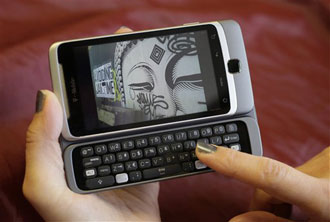HTC G2 Impressive on T-Mobile's Faster Network
By wchung | 11 Sep, 2025
Two years ago, the Android invasion began when T-Mobile released the first smart phone running Google’s Android operating system, HTC’s G1.
Since then, a parade of increasingly capable and sexy-looking Android phones have hit the market, making the G1’s then-cool 3.2-inch touch screen and side-sliding QWERTY keyboard look quaint. One more just joined the fray: the G1’s successor — a speedier, flashier and more capable smart phone called the G2.
Like the G1, the G2 is equipped with a touch screen and a physical keyboard that slides out from the side. Other than that, though, it’s a completely new device that is bulky yet quick and clever.
On the surface, the G2 is eye-catching with its combination of brushed metal and silvery rubberized plastic flanking a large touch screen that runs 3.7-inch diagonally.
And, when you can find T-Mobile’s new network, called HSPA+, it is speedy, too. The G2 is the first phone that operates over this new network — essentially a souped-up version of its existing 3G cellular network — which is meant to make such tasks as downloading apps, streaming videos and surfing the Web much zippier.
One evening, I visited one of the spots in San Francisco where I was told I’d find this faster network, pulled out the G2, and immediately saw a huge change in speed. Suddenly, high-quality YouTube videos played back quickly and flawlessly, without needing tons of time to restart at the right place when I tried to fast forward or rewind. Web pages loaded faster than I could groan about slow loading times.
In a way, it’s a good thing that this network only exists in small pockets. To find one in San Francisco, T-Mobile had to equip me with a list of local businesses that are in range. If it were everywhere, I might have gotten hit by a car while in a mobile movie-watching stupor.
You’ll probably end up sticking with the more ubiquitous 3G network for now. T-Mobile has turned on these faster speeds in various cities across the country, but it hasn’t yet blanketed these places with coverage.
Fortunately, the phone is pretty speedy even without the latest network. Over 3G, the G2 froze often while I streamed videos from YouTube, but clips did look crisp on its bright screen when they played properly. The phone performed pretty well when checking out websites or looking for directions in Google Maps, too.
The G2 comes with the latest Android software — version 2.2, also known as Froyo — which means it has such features as the ability to understand lots of voice commands and, unlike Apple’s iPhone, to run Flash animation and video.
It’s also loaded with plenty of Google Inc.‘s apps, including Google Voice, which can do such things as automatically transcribe your voice mails (not very well, in my case). Another is Google Listen, which lets you search through online audio feeds and stream or download them to your phone. I used the latter to indulge in a podcast that dissected the finer points of a recent “Glee” episode.
While plenty of Android phones have said goodbye to the physical QWERTY keyboard, preferring instead to stick with an on-screen facsimile as the iPhone does, the G2 keeps it as one of several typing options. It’s easy to type on, and I liked the convenient placement of three programmable shortcut keys.
But because the G2’s on-screen keyboard includes Swype — an easy-to-learn third-party application that lets you type on virtual keyboards by just swiping your finger from letter to letter — I rarely felt the need to break out the actual keyboard. As adept as I am at tapping away on tiny keyboard, I’m faster at wiggling my finger around on a virtual one. And a virtual keyboard has no hinges to pinch my tender digits when I slide the screen closed.
Frankly, I kept wondering how much skinnier and lighter the 6.5-ounce handset could be if it ditched the keyboard. (Compare it, for example, with the much larger Motorola Droid X, at 5.8 ounces, or the solid-feeling iPhone, at 4.8 ounces.) Sure, the G2 can fit in my back pocket, but its heft means I never forget it’s there.
I was impressed with one feature that seems to get overlooked on phones packed with so many features: sound quality. Calls generally sounded crisp, and during one call the friend on the other end couldn’t even tell that I had put him on speakerphone.
Speaking of bells and whistles, with all the phone’s fun options I feared the G2 would be a total battery hog. Fear not: While it is rated for 6.5 hours of talk time, it did a good job of holding up through a full day of texting, talking, video-watching and Web surfing.
While the G1’s release heralded the start of a new smart phone order, offering consumers an excellent alternative to Apple Inc.‘s iPhone and Research In Motion Ltd.‘s BlackBerrys, the G2’s arrival is much less dramatic. Still, by showing just how far Android has come in just two years, it makes a worthy successor.
RACHEL METZ, AP Technology Writer SAN FRANCISCO

An HTC G2 phone from T-Mobile is the successor to the first smart phone running Google's Android operating system, HTC's G1. The basic design is similar, but the phone has gotten a major overhaul in terms of style, speed and functions. (AP Photo/Eric Risberg)
Asian American Success Stories
- The 130 Most Inspiring Asian Americans of All Time
- 12 Most Brilliant Asian Americans
- Greatest Asian American War Heroes
- Asian American Digital Pioneers
- New Asian American Imagemakers
- Asian American Innovators
- The 20 Most Inspiring Asian Sports Stars
- 5 Most Daring Asian Americans
- Surprising Superstars
- TV’s Hottest Asians
- 100 Greatest Asian American Entrepreneurs
- Asian American Wonder Women
- Greatest Asian American Rags-to-Riches Stories
- Notable Asian American Professionals

